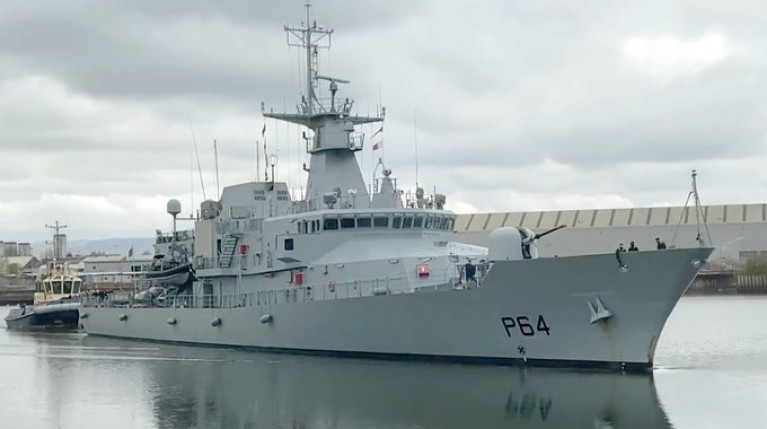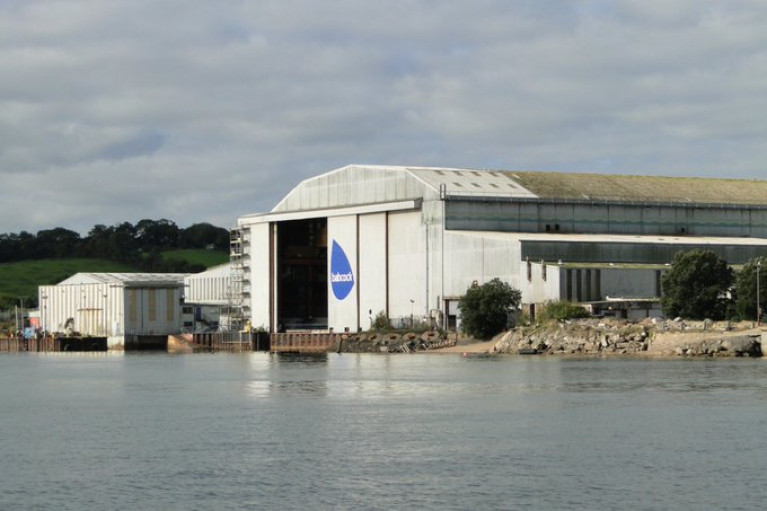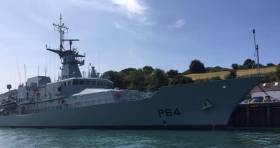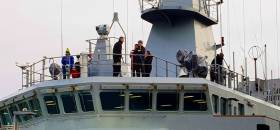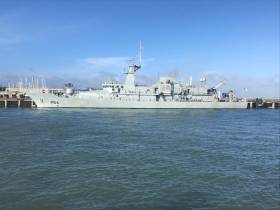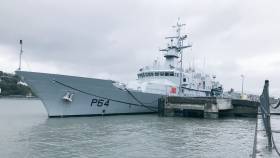Displaying items by tag: LE George Bernard Shaw
Sole Active Naval Service Ship Unavailable for Cork Drugs Search due to St Patrick’s Day Call in Dun Laoghaire Harbour
LÉ George Bernard Shaw, the sole operational ship of the Naval Service, was unavailable to take part in a large drug search off the Cork coast this weekend as it formed part of St. Patrick’s Day festivities held in Dun Laoghaire Harbour.
Last week, when Gardaí investigating a suspected attempt to land a large consignment of cocaine near Skibbereen in west Cork, made a formal request to the Naval Service for the use of the P60 class offshore patrol vessel (OPV) to assist in the search.
The request took place while the LÉ George Bernard Shaw was bound to Dún Laoghaire Harbour to take part in the St. Patrick’s festival. This involved the 90m vessel berth at the port town’s Carlisle Pier, featuring new fendering that is also to cater for commercial ships.
The Navy’s newest patrol ship, built in 2016, remained in the south Dublin Bay town over the weekend, where the public was offered tours. On St. Patrick’s Day, 25 of the ship’s 44 crew members took part in the town’s parade along the coast road.
With the patrol vessel and crew in port, this meant there was no naval ship available to assist in searching the thousands of square kilometres off the Cork coastline where the drugs may be located.
Much more The Irish Times has to report on the crew crisis challenging the navy, which has among its duties drug interdiction.
LE George Bernard Shaw Benefits From New Ship Fender Installation at Dun Laoghaire Harbour's Carlisle Pier
The Navy's LE George Bernard Shaw was one of the first arrivals of the season to use the new ship fender installation at Dun Laoghaire Harbour's Carlisle Pier.
As regular Afloat readers recall, the installation in August 2023 of nine new fenders supported on tubular piles is to increase the capacity and flexibility of the quay for berthing a range of vessels which moor at the Harbour.
LE George Bernard Shaw arrived for the St. Patrick's Day festivities, and her crew took part in the town's first St. Patrick's Day parade for decades.
Visitors to 'berth number three' include Navy ships, cruise liners, wind farm service and research vessels, beam trawlers and visiting superyachts.
 Some of the new ship fenders visible to the left of the bow of the the Navy's LE George Bernard Shaw Photo: Afloat
Some of the new ship fenders visible to the left of the bow of the the Navy's LE George Bernard Shaw Photo: Afloat
The project required the demolition and removal of three existing concrete buttresses and steel fender collars.
It has been a busy time for upgrading the 200-year-old harbour as the fender installation occurred, as separate €2m works were completed to the revetement at the back of town's East Pier.
The works follow extensive repairs since March 2018, when Storm Emma caused serious damage to the East Pier.
Dún Laoghaire Harbour this Friday is to welcome the Naval Service OPV LÉ George Bernard Shaw (P64) ahead of the St. Patrick’s Day Celebrations.
The Offshore Patrol Vessel (OPV) is named after the renowned playwright George Bernard Shaw, who had a significant influence on Western theatre, culture, and politics, the naval ship will be open to the public for guided tours on Saturday 16th and Sunday 17th March. The crew will also be taking part in the St Patrick’s Day Parade, Dún Laoghaire on Sunday at 11am.
The 90m (OPV) will be berthed at Carlisle Pier, Dún Laoghaire Harbour, with tours by the crew available from 12-3pm on Saturday and 1.30-4pm on Sunday. This is a unique opportunity for visitors to explore the ship, learn about its capabilities, and gain insight into its role in defending Ireland's interests at sea. Tours are free of charge, no booking required and last approximately 20 minutes.
"Dún Laoghaire harbour has a well-established connection with the Irish Naval Service for over 100 years and we continue to build that relationship through our shared maritime heritage. We are honoured to welcome the captain and crew of the LÉ George Bernard Shaw to Dún Laoghaire Harbour this weekend. This is an opportunity for a new generation to visit and see this incredible Offshore Patrol Vessel, which has the endurance and capability to defend Ireland's interests at and from any sea in the world” said Councillor Denis O’Callaghan, Cathaoirleach, Dún Laoghaire Rathdown County Council.
Dún Laoghaire Harbour has a strong connection with the Irish Naval Service, highlighted by the yearly visits and the naming of the Irish ship L.É. James Joyce (P62) during an official ceremony at the harbour. In 2017, Dún Laoghaire-Rathdown County Council bestowed the Freedom of Entry to the County on the Irish Naval Service in recognition of its humanitarian service on behalf of the people of Ireland, recognising the shared maritime connection between the Irish Naval Service and Dún Laoghaire Harbour. The Dublin built gun boat HMS Helga frequently stationed in Kingstown and shelled Dublin city during the Easter Rising, was later bought, and renamed Muirchú, the first fishery protection principal vessel of the Irish Coastal & Marine Service in 1923 which subsequently became the Irish Naval Service in 1946. HMS Helga was also responsible for rescuing 90 passengers after the RMS Leinster was torpedoed off Dublin Bay in 1918.
Frank Curran, Chief Executive, Dún Laoghaire Rathdown County Council said: “Dún Laoghaire Harbour is embarking on an exciting transformation that will pave the way for a vibrant and inclusive future. The Harbour Master Plan and the establishment of a National Watersports Campus will revolutionise the harbour, turning it from a traditionally industrial port into a people-focused space that benefits the entire community and the Irish Naval Service visits to Dún Laoghaire will be an important consideration within that plan. This transformation aligns with the town’s vision of becoming a premier maritime, tourism, and economic destination”.
If you are interested in finding out more about Dún Laoghaire’s maritime heritage, why not visit the National Maritime Museum located beside the dlr LexIcon that is housed in a 180 year old Mariner’s church and is only one a of few custom built places of worship for seafarers that remains intact in the world today or discover the Dún Laoghaire Harbour Trail which brings to life the stories of how the pier was built and why it is so historically important.
A Naval Service patrol vessel visited Scotland, the first to do so in over 10 years which arrived this week.
The LÉ George Bernard Shaw arrived in Glasgow with the Royal Navy in Scotland sharing images of the Offshore Patrol Vessel on Twitter.
The Samuel Beckett-class offshore patrol vessel was designed by Vard Marine and built by Babcock Marine in Appledore, and is named after the writer George Bernard Shaw.
Designed to patrol and protect the Irish Sea, the ships are also used out on the Atlantic.
The ship was accepted into service in October 2018, and, following a military fit-out, has commenced Maritime Defence and Security Operations at sea. Additionally, the ship recently conducted night operations & fishery protection duties.
More reports Daily Record, on the ship that docked in the King George V Dock.
Afloat adds the dock is located downriver of the nearby 19th century Govan Docks where a scheme is to reopen the facility to enable ship-repairs.
In the UK the Government has been accused of ‘dither and delay’ following claims a viable buyer has been lined up for Appledore shipyard for four months.
The GMB Union, according to NorthDevon Gazette, (yesterday, 31 January) criticised the Government for ongoing delays in the potential re-opening of the yard as Afloat previously reported.
GMB said it and its sister trade unions have been involved in ongoing negotiations, led by the South West Business Council, to re-open the yard and secure a viable future.
Matt Roberts, GMB organiser, said: "A buyer with a viable proposition has been lined up for over four months now, but there seems to be dither and delay from the Government, causing more uncertainty for our members.
More on this story click here
For previous Afloat coverage on the shipyard's final vessel LÉ George Bernard Shaw which last year joined the Irish Naval Service.
Hopes UK Shipyard in Appledore Could Reopen After Top Level Government Meeting
In the UK, a Torridge MP is ‘cautiously optimistic’ Appledore Shipyard will reopen in the near future after a crucial meeting at Downing Street.
As the North Devon Gazette reports, it follows a high level meeting convened by Geoffrey Cox at 10 Downing Street (yesterday) with the UK Government's taskforce dedicated to reopening the shipyard.
The taskforce, led by SW Business Council chairman Tim Jones has been working with the MP since the withdrawal of operator Babcock and the closure of the yard in March this year to secure new owners and to provide the Yard with a stable future.
Mr Cox, who has met potential owners and new customers to secure their support for the Yard over recent months has said that he is now 'cautiously optimistic' about its future, particularly as the Government has announced its intention to revive British shipbuilding.
The meeting heard from the Mr Cox of the shipbuilding heritage on the Torridge and its importance to the local economy.
For on this story can be read here.
Waterford welcomes the Naval Service’s newest offshore patrol vessel LÉ George Bernard Shaw for its official naming and commissioning ceremonies today, Tuesday 30 April.
Public viewing of the ceremonies will be from the William Vincent Wallace Plaza in the city centre.
LÉ George Bernard Shaw was delivered from the Babcock Marine Appledore shipyard in Devon to Cork Harbour last October.
It is the fourth and final ship of the P60 class commissioned over recent years, after LÉ William B Yeats, LÉ James Joyce and LÉ Samuel Beckett.
UK Shipyard Closes As Appledore's Final Ship Sails But Opens to Visitors in Cork On St. Patrick's Day
#ports&shipping- In the UK, Babcock International has closed its Appledore shipyard yesterday, bringing down the shutters on the site in north Devon after almost two centuries.
As The Times reports, workers described the day as “heartbreaking” as they walked around the shipyard, where nearly 200 vessels have been built since 1855.
In November Babcock had confirmed that it would end its lease in Appledore after 11 years. Afloat adds the final ship to be built at the facility is the Irish Naval Service newest OPV90 / P60 class LÉ George Bernard Shaw which was floated-out just over a year ago.
The FTSE 250 defence company said that it had taken the “difficult decision” because it did not have enough work to sustain the facility. Babcock’s 199 staff at Appledore have been offered the chance to move almost two hours’ drive away, to Devonport, in Plymouth, on the opposite side of the county.
Afloat also adds the €67m OPV which was designated pennant No. (P54) is berthed in Cork City along Albert Quay where the public had free guided tours today and they will continue tomorrow on St. Patrick's Day. The guided tours will be made available by the ship’s crew between 14.00 and 17.00 hours.
First Visit to Dun Laoghaire Harbour by Newest OPV L.E. George Bernard Shaw
#navy - A first-ever visit to Dun Laoghaire Harbour of the Naval Service newest OPV P60 class took place last weekend, writes Jehan Ashmore.
The fourth of the Offshore Patrol Vessel class sisters to enter service, LÉ George Bernard Shaw which cost €67m docked at the Carlisle Pier on Saturday.
Originally, the 90m vessel arrived into Irish waters from UK shipbuilders last year in the month of October.
This inaugural call to Dun Laoghaire Harbour follows sisters among them LÉ James Joyce which was christened and commissioned into service in 2015.
All of the quartet were built by Babcock International at one of their English facilities, the north Devon shipyard in Appledore, which however closed down last year. This places the 2,250 tonnes vessel as the final ship to be launched from the facility near Bideford.
Newest Ship in the Irish Navy Open to Tours in Galway Docks
#NavalService - LÉ George Bernard Shaw, the latest ship to join the ranks of the Irish Navy, will be open for the public to look around next week in Galway Docks.
As the Galway Daily writes, LÉ George Bernard Shaw was brought into Naval Service this year and will have a formal naming ceremony in 2019.
The Offshore Patrol Vessel is the latest of four modern ships delivered to update the Irish Naval Service since 2014.
Free guided tours of the ship will be offered to the public by her crew on Monday, December 31 and Tuesday, January 1 from 2pm to 5pm.
The four ships built for the navy since 2014 are often referred to as the ‘Playwright’ sisters, for more read here.


























